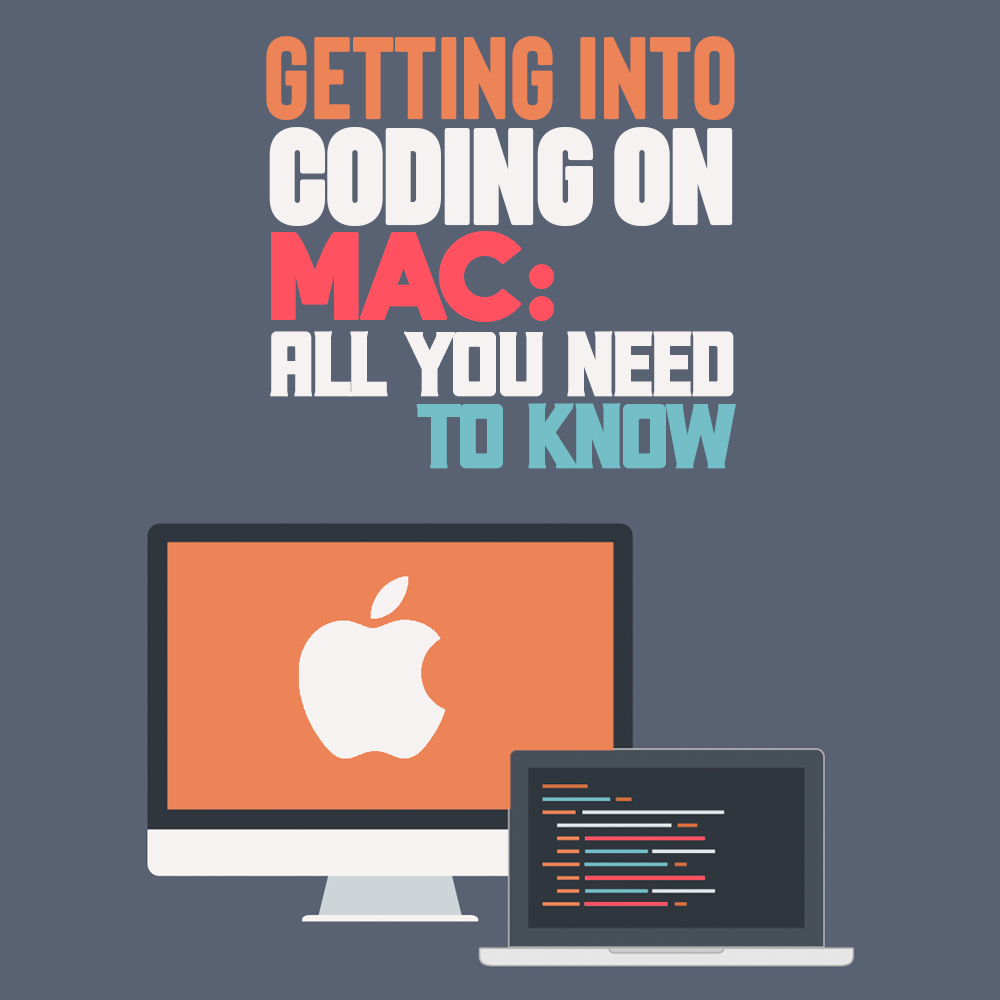 A safe assumption to make is that every programmer wishes to work with a computer with great speed and can handle applications effectively. Most programming enthusiasts who have developed programs with Mac and any other computer will agree that the Mac environment is better than the majority of other computer environments.
A safe assumption to make is that every programmer wishes to work with a computer with great speed and can handle applications effectively. Most programming enthusiasts who have developed programs with Mac and any other computer will agree that the Mac environment is better than the majority of other computer environments.
The effective cross-platform compatibility is one of the main reasons why Mac is so popular and should be considered for your coding activities. In other words, if you choose to work on a Mac, you can run most major applications on your computer without hassles.
To continue the conversation, here are things that you need to know when getting into coding on Mac. But first, let’s take a look at something you should do before you start editing.
Adjust MacOS settings
Before you start coding on Mac, there are several system settings that you need to adjust to make the coding process more effective. Log in and run a software update to ensure that you are working with the latest point release of the application. Installing the latest updates will provide your system stability and security.
Installing Homebrew
If you are a beginner, create a user account for your use. You will always log in with this new Admin account. So, unless you give someone else your password, it will never interfere with your code. To adjust settings and set up your Mac for the coding development, sometimes you must install command-line tools from the App store.
- Install Xcode from the App Store and then open a window terminal and enter “Xcode-select – install.” This will be discussed in detail in the later paragraphs.
- You also need to set up Homebrew, as it provides a package management system for the macOS. This app allows you to quickly install and update any tool and the libraries containing the programs you have created over time. Ensure that you amend PATH so that the new versions of the tools installed with the Homebrew can take precedence over all others.
Auto-completion of Commands
Another step to adjusting your Mac settings for coding is enabling auto-completion of command which is provided by most of the command-line tools. For the adjustment, you must edit your file. zshrc in the home directory.
You can also install Rectangle on your Mac. Rectangle will help rearrange the window size with key shortcuts. Regardless of the desktop setup you are working with, you will need shortcuts for arranging the windows. This can either be to the side, maximizing the current virtual desktop or centering your windows.
After downloading the Rectangle app, add its accessibility within the security and privacy setting. When you are done, you can now use it to adjust the window size settings. Regardless of the editor's choice, you ensure that you set the EDITOR environment variable to allow it to be automatically invoked by the command-line tools.
To keep your code projects neat, you have to set up a directory structure for your projects. Create a top-level directory with a short generic name that you can easily remember. For each repository host, make sure that you create a subdirectory.
If you are interested in the resource monitor at the top of the terminal, enable the status bar and click on the “configure status bar” to see all the available options. There are still settings that will allow you to reverse the mouse scroll. You can set the mouse to scroll direction independently while keeping the trackpad in the natural scrolling.
Manage Keyboard and Shortcuts

Investing your time in learning several simple commands that are useful for coding will pay off greatly in time saved. Research shows that learning to manage the keyboard and integrating different shortcuts increases productivity.
That's because you become more comfortable writing and editing codes more efficiently than before. And this will boost your confidence as you try to teach other first-time coders how they can easily do that. There are various keyboard shortcuts that you can learn to improve your overall coding process. Below are some of the tasks that you can accomplish with various keyboard shortcuts.
To cut, copy and paste, you can use the following keyboard shortcuts. Press Apple Key + X, press Apple key + C, and lastly, press Apple key + V. The first keyboard shortcut, Apple Key + X, will help you cut a code section from any of your files. This means that the highlighted code will get deleted from the screen completely, and it will never be available not unless you paste it again.
In the second shortcut, Apple key + C, you are copying a code section without permanently deleting it. You are trying to paste the duplicated copies elsewhere in the code file for the last shortcut. Save the code files by pressing the Apple key + S.
This saves valuable time instead of selecting the “save” command from the drop menu. If you want to comment on sections of the code, press the Apple key + /.
Toggling between tabs is usually performed by pressing Ctrl + Tab to the Right and Ctrl + shift + Tab to toggle and make the right decision. To search within files, press the Apple key + F. Then, enter the text you are looking for, and it will be highlighted.
Install Coding Apps
With the advanced technology, coding IDEs and other applications have been developed to help with effective coding. Even though Mac comes with significant loads of software that will help you achieve your goals, there are coding apps you need to install on your Mac.
There are two options, you can either download and install the app for free or for premium subscriptions. Navigate to the Mac App Store to search for the coding apps you are looking for. You can still download apps that are not on the store from their developers’ sites.
These apps will help you write your code effectively, debug to check the errors in the code and run the code to see the output. Knowing how to install different apps on Mac will make it easier to download and install various coding apps. If you want to install an app out of the play store, read the reviews about its functionality to avoid making the wrong choice.
Whenever you settle on the best app to download, you can click on its icon to open the dedicated page. Here, you see an outline of the various user reviews, functions, and screenshots of what the app looks like. Then, continue to install the app from the store.
Spotlight Download
You can press Command + Space to open Spotlight and type the name of the app that you have downloaded. That's if you want to find it easier than navigating through various steps. On the other hand, you can also download these apps from the web. But you have to be extra careful about what you are doing. It’s important to remember, many apps on the internet are full of malicious elements that will infect your application.
Visit the app's site and then navigate to the download option. Click on the download button and use the same procedure to install the app on your Mac. The Mac’s security applications will scan the app before installing it to ensure it's free of viruses and other suspicious elements.
Not Mac Friendly Apps
Not every app you need for coding will be supported by Mac. So, how do you go about this? In this case, you can use virtual machine software to download the software and install it on the computer. There are numerous virtual machine software applications on the internet that you can download to use.
Make sure that the installed apps are updated frequently, as this is the only way to ensure that everything works harmoniously. You can also create a virtual machine that mimics the hardware components using the virtualization programs like VMWare and Parallels Desktop.
Modify Terminal
Terminal is the command-line interface for the Mac. Terminals are used to initiate actions that are supported by the user interface of the operating system.
Most of the terminals that are not modified are not exactly pleasant to work at or deal with. Before you start coding, customize the terminals. Modifying the terminals will help later when tweaking other new modifications to meet your preferences.
The first step to modifying the terminal is setting a theme. Click on the Terminal window and then select Terminal. After that, navigate to Preferences. You will see a list of the default Terminal profiles you can use in your coding environment.
Additionally, you can add a custom theme that you have created and stored in your GitHub account. This is the better option because you can always change it later.
After you have selected your themes, you can set your preferences. These include the text tab, window tab, tab tab, keyboard tab, and the shell tab. For instance, with the text tab option, you can deselect the Use Bold Fonts and allow Blinking Text. The window tab is mainly used for deselecting the active process name, dimensions, and arguments.
For the case of the tab tab, you use the preference setting to deselect the active path or active process and show the activity indicator. The keyboard tab is used when dealing with selections of the Meta key, and makes the Terminal look better than in the default setting.
You can leave it at this point, but you can also continue further and configure .bash_profile. This is usually done via the nano editor, as you only need to add and save a few lines. Still, you can use emacs, vim, and whatever editor you are comfortable with.
Purgeable Space

To get rid of those messages, you can run the command “touch .hushlogin.” It will automatically carry out the cleaning process for you. The main way you will be able to enjoy your coding process and have an excellent experience for learning is through customization of your digital space.
Lastly, you can configure aliases to make your Terminal experience with coding a little better. Aliases helps to create a shortcut name for command, shell text or file name. There are several shortcuts you can use to set up useful aliases. You are not limited to what you can set, and that's why you can decide on anything that you think will improve your experience.
Choose Command-line Tools
Various command-line tools are available that you can use for a better coding experience. What you should understand about these command-line tools is they won't make you a great programmer, but they will make you feel like you are a great programmer. Being a great programmer lies in dedication to the right things and trying as many coding challenges as possible. To install command-line tools on your Mac, you must follow the following steps:
- Ensure that you update your macOS version. This will improve the compatibility of the Mac with the command-line tools. Older versions of Mac may not be in position to support some of the command-line tool features.
- Check whether the Xcode command-line tools are already installed. If they are not, you can install the Xcode command tools with Homebrew. It's the most recommended method to use. Alternatively, you can install the Full Xcode package for the command-line tools.
These tools are built with Apple LLVM compiler, Make and linker, which make the compiling process more excusable from the source code. There are different command-line tools that you can use to enhance your experience.
You can use the system tool. One of the main reasons why most programmers hate terminals is that you can't manipulate files like in finder. But with the system tool, you can quickly achieve this. There are mainly two open-source command-line file managers that you can use as system tools.
These open-source command-line file managers include ranger or nnn. Ranger is written in python and offers a quick start to the programmers. On the other hand, nnn is a full-featured terminal manager that is very fast.
Command Enhancement Tools
Some of the software applications installed for coding have many native commands that are available for basic use under the Terminal, while some of them are not good to use at all. So, you need to use command enhancement tools.
Some command enhancement tools you can use on your Mac include the exa, fd, and bat. Exa is a modern tool that can replace the LS commands. It’s an improved file lister that has more features and better defaults. Exa uses colors to distinguish metadata and file types.
On the other hand, fd is a simple, fast, and easy-to-use tool for searching that you can use to replace the Find tool. It uses truncated syntax and abbreviated command structure to keep the commands typed short.
Bat is a command enhancement tool of the CAT. This is a great tool, especially when it comes to translation. Bat files are used to automate routine commands without your input or intervention.
There are lots of wonderful and fun tools that you can use to enhance your coding experience with Mac. Each tool selected should be used with a lot of care to cover long-lasting service. Remember, the hands of programmers are the hands of magicians who transform written code into great software through various tricks on different IDEs.
Ready, Set, Go!
Coding with Mac offers better experience when you adjust your settings and install needed applications for the great development environment. You can adjust your MacOS settings to fit into the preferences that you highly prefer. Learn keyboard and the various shortcuts used. Understand the process of installing useful codes and modifying the terminals. Lastly, choose the command-line tools you need in your Mac. If you are ready and set to go, you can get started with coding on Mac.
